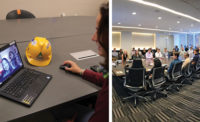National Academy Report Sees Ways To Build the Future
We’re wearing out the planet as well as our water, energy and transit systems, according to the National Academies of Sciences, Engineering and Medicine’s Dec. 3 report, “Environmental Engineering for the 21st Century.” The solutions NASEM suggests could not only save Earth and its denizens, but also boost the construction industry—with opportunities to transform aging infrastructure, erect energy efficient or healthy buildings, and build indoor farms.
Vertical farms can produce food with recycled water and nutrients, the report said. “Because such farms do not require agricultural land, they can be located close to urban centers,” it said. And that could spark further revitalization.
“AeroFarms’ indoor aeroponic growing facility in the Ironbound neighborhood of Newark [N.J.] is a great solution for industrial communities looking to spur urban redevelopment,” says Ron Beit, CEO of RBH Group, the building owner-developer of AeroFarm’s facility, a $30-million, 75,000-sq-ft steel plant conversion. Marc Oshima, AeroFarms’ chief marketing officer, adds the company has built nine farms that require space of at least 70,000 sq ft with a minimum 36 ft ceiling clearance, and has more in development in the Middle East, Northern Europe and China.
NASEM’s report also highlighted healthy buildings made of materials that don’t release gaseous toxic compounds and have optimal ventilation and lighting. “Healthy buildings are a critical component of healthy cities because people spend over 90% of their time indoors,” it says.
The biggest construction challenge is retrofitting existing buildings and infrastructure, since tenants’ budgets don’t usually include overall building systems, according to Rob Leon, senior vice president of global services at Structure Tone.
“What we’re seeing now is a shift (in the green building trend) toward wellness,” says Leon, whose firm found that 93% of clients it surveyed agree that wellness features are a core requirement or emerging need of their real estate.
Energy-saving buildings seem to remain lucrative, per NASEM's report.
"Tenants are looking to meet their own company sustainability goals while also looking for cost savings opportunities,” Edward V. Piccinich, chief operating officer of SL Green, tells ENR. “On the base building side, SL Green has invested over $60 million in energy efficiency projects."
Finally, NASEM’s report emphasizes aging physical infrastructure, including water systems and transportation, and new infrastructure solutions such as decentralized energy grids, as perhaps the biggest opportunities for construction. NASEM notes U.S. infrastructure will require $4.6 trillion in investment by 2025, per the American Society of Civil Engineers, and that the Organisation for Economic Co-operation and Development estimates a $70-trillion need for global infrastructure by 2030.




